Ever come across a belt in your car hood that resembles a snake? If the answer is yes, that is most certainly a serpentine belt.
A serpentine belt plays a vital role because nothing will work without it. But are you sure that you know clearly about it and what to do if it is bad or broken?
Looking no further, this article will equip you:
- Detailed information about the serpentine belt
- Signs of a bad serpentine belt and what happens if it breaks
- How to replace a serpentine belt
- Serpentine belt replacement cost
Let’s read on!
Serpentine belt basics
What is a serpentine belt?
Otherwise called drive belt, alternator belt, or fan belt, the serpentine belt is that long rubber belt that transfers power to your car’s engine’s various accessories. It holds all parts together and ensures your engine functions properly.
The serpentine belt has several important functions that it performs in a vehicle. You may not know this if you aren’t a mechanic. But don’t worry – that’s why I’m here. Check out some of the top functions of a serpentine belt below:
- Powering the accessories of an engine
- Increasing the engine’s overall efficiency
- Preventing overheating and keeps the engine water pump running
- Helping a vehicle’s electric charging system function properly.
Serpentine belt vs. V-belts vs. Timing belt
| Serpentine belt | V-belts | Timing belt | |
|---|---|---|---|
| Application | Used mostly in new vehicles | Used in old and new vehicles | Used on the older, classic vehicles |
| Function | Transfers power to your car’s engine’s various accessories | Transfer power to your car’s engine’s various accessories | Connects a camshaft with a crankshaft and keep then in sync |
| Location | On the outer part of your engine block | On the outer part of your engine block | On the inside of the car’s engine |
| Number | Single | Multiple | Single |
Serpentine belt
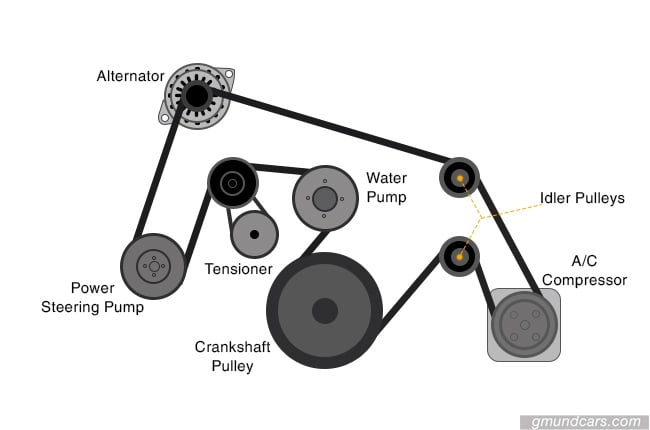
It’s not rare to find people confuse serpentine belt with timing belt. Except you’re a pro, you might be tempted to think they’re the same. But the fact is, they are not. Unlike V-belts, the serpentine belt is used mostly in new vehicles, and it winds around multiple pulleys.
It is the long, rubbery belt located on the outer part of your engine block. You don’t even need a microscope to notice that. Look at your vehicle’s engine block, and you’ll find it staring at you.
The serpentine belt is a single belt running continuously, and like a snake, it coils around other engine accessories to supply power.
V-belts
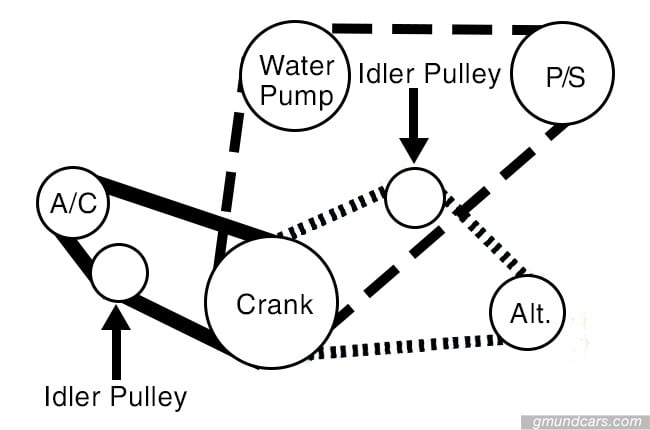
You’ll find V-belts in an array of construction types and sizes. So it won’t matter that your drive has low or high horsepower. They have the same functions as the serpentine belt. However, they come with many belts, and they are used on the older, classic motors.
There are mainly two kinds of construction available for V-belts—raw edge and wrapped. While wrapped construction belts are covered externally with fabric, raw edges are not. And unlike the wrapped, raw-edge construction belts hardly slip.
Nowadays, modern vehicles use serpentine belt instead of V-belts. So, if you look inside your car and find one belt running through all the engine components, it’s the serpentine belt. Otherwise, if there are several belts around those components, they are V-belts.
Timing belt
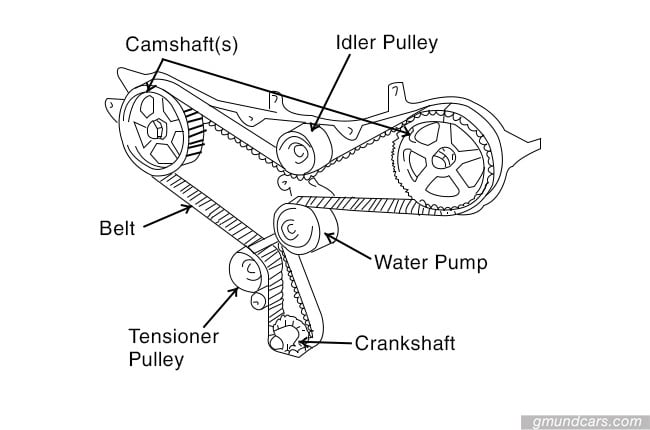
Don’t go looking for a timing belt on the exterior of your engine – you won’t find it. The timing belt is located right on the inside of the car’s engine. It does the gears’ work at times and moves the camshaft when they’re unable to.
Not only that, a timing belt prevents collision between camshaft and piston. And in some cases, it runs both the engine’s water pump and oil pump.
Timing belts have just one belt, like serpentines. But function quite differently from serpentines. The main purpose of a timing belt is to connect a camshaft with a crankshaft and make sure they stay together – it does this with its teeth, which are located on the inside top of the belt.
How often to replace a serpentine belt
A serpentine belt needs to be replaced periodically – usually around every four to six years, depending on its conditions.
Keep in mind that the advancements of rubber technology these days have made serpentine belts more durable. All things being equal, your belt should remain intact for about 60,000-100,000 miles. But when it breaks, replace it immediately, so you don’t have to pass the night on the highway.
Signs of a bad serpentine belt
A bad serpentine belt is a disaster to every vehicle. It might cause overheating or lead to serious damage to the engine accessories. And, no, this isn’t one of the car issues you can fix in minutes. It requires time, effort, and of course, a lot of money.
It’s easy to know when you should replace your serpentine belt. With the following signs, you can tell there’s a problem, and it’s time to upgrade:
Squealing or chirping noises
When your vehicle begins to make squealing sounds at the front, you know there’s a problem. At times, it takes just a realignment to fix. But in some other cases, you might need proper tensioning.
The louder the noise, the higher the possibilities of damage. When it gets too high, you know the belt is damaged and needs a total replacement.
Cracks and wears (cracking, glazing, fraying, etc.)
Once there are visible cracks or wears on the belt, it means it is bad and due for the curbs.
Another way to know when your serpentine belt is bad is to examine it closely. Of course, the belt is one of the easiest accessories to access in the vehicle. So there’s no need to look far.
What happens when the serpentine belt breaks?
Recall I said the serpentine belt is important? Oh yeah, it is. If you’ve never had your belt broken or damaged for once, you might not understand. Remember! When you have discovered these signs, you must replace your serpentine belt immediately. Another factor is to choose the best and compatible belt with your car. It’s really important.
When the serpentine belt breaks, you see that all of the engine accessories below will shut up or don’t work anymore:
- Alternator won’t charge your car’s battery and power electrical systems
Your engine’s alternator powers the electrical system of the vehicle; it also recharges the battery while in operation. But if your serpentine belt breaks, the alternator would not spin anymore. And this may eventually result in a dead battery or prevent your car’s alternator from delivering power to the electrical systems of the vehicle. This can either cause headlights to go dim, make the car’s radio stop working, or other problems.
- Power steering won’t allow the steering to become easier or air conditioning won’t cool the driver and passengers
A broken serpentine belt can lead to power steering loss in your vehicle. And, this happens very suddenly. You may find it difficult to turn your steering while in the middle of a very busy intersection, and that’s dangerous. Also, your car’s A/C might refuse to work when belt is faulty.
- Water pump won’t circulate coolant through the cooling system of the engine
When the serpentine belt wears out, the vehicle’s water pump ceases to circulate coolant through the cooling system of the engine. And that usually results in overheating.
How to replace a serpentine belt
Preparation
After figuring your belt is damaged, the next thing to consider is a replacement. Anyone can replace a serpentine belt in a car, but not without a guide. And though the process of replacement varies slightly from car to car, it’s quite very simple.
Step 1: Tools needed
- Socket
- Ratchet or breaker bar or a serpentine belt tensioning tool
- New serpentine belt (make sure to consider the compatibility of the product to your car)
- Axe stands
- Jack or ramps.
Step 2: Turn off your vehicle and lift the hood so that the engine can cool down.
Step 3: Identify where the serpentine belt is. After opening the hood, you will see it’s located in the front of the engine and runs like a snake through several pulleys.
Step-by-step guide
Remove old serpentine belt
Step 1: Check out for routing layout of the car’s serpentine belt. Each model is usually different, but you can find yours in the owner’s manual (or somewhere around the engine compartment). For an easy reference, take a picture of the diagram so you’ll have it handy.
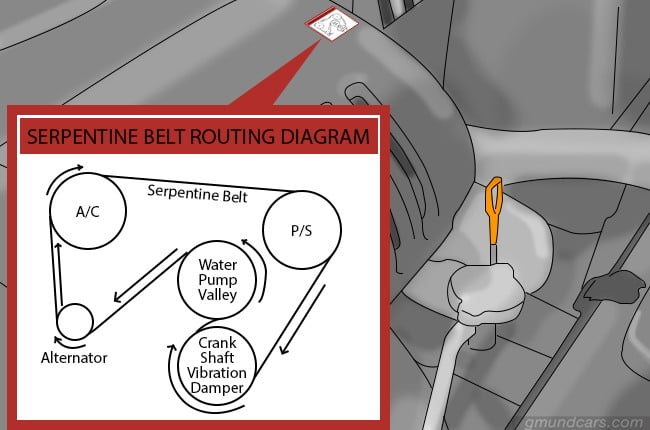
Step 2: In some cases, you may have to make a sketch of the belt routing. Your diagram should indicate where the tensioner is located. Then use your ratchet and socket to rotate the tensioner and to ease tension on the serpentine belt. Slip the belt off the pulleys, and if you need more leverage, use a breaker bar. And as soon as the belt is slipped off, you can remove your ratchet from the tensioner.
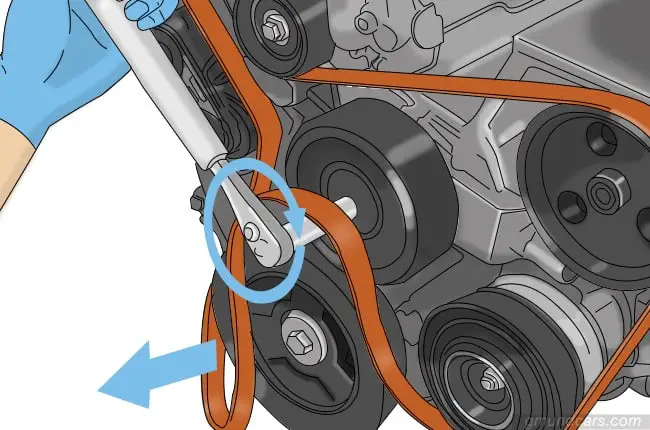
Step 3: Now, remove the belt completely.
Install new serpentine belt
Step 1: Compare new and old belt
The first thing to do when replacing the serpentine belt is to compare the new with the old. You need to be sure the width and number of ribs are the same. However, the old belt might be a little longer than the new.
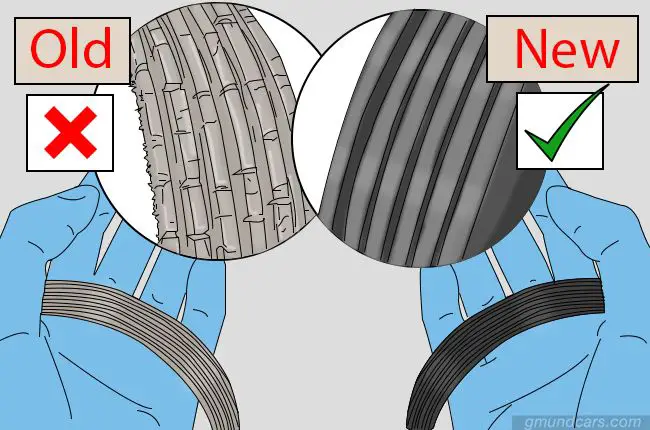
If the width difference is so large, then it isn’t right – you might need to get another belt. Make sure you’re buying a perfect belt so it doesn’t tear with use.
Step 2: Run new belts through pulleys
Run a new serpentine belt through your car’s pulleys, but ensure it is done in the same way as the old. You can refer to your manual’s belt diagram or the picture you took at the “remove old belt” stage for guidance.
Get a belt long enough to go round all pulleys but the tensioner – till the pressure on it is completely relieved.
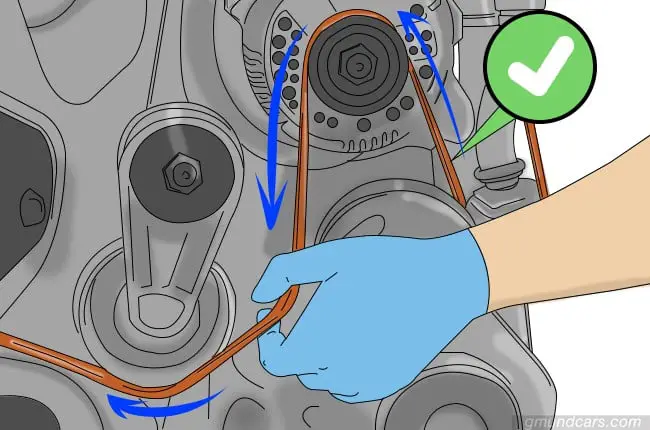
NOTE: Your belt will loosen if you route it wrongly. It will also not fit well if the size is wrong. So be guided.
Step 3: Increase tension on belt
Apply tension on the belt through by activating the belt tensioner.
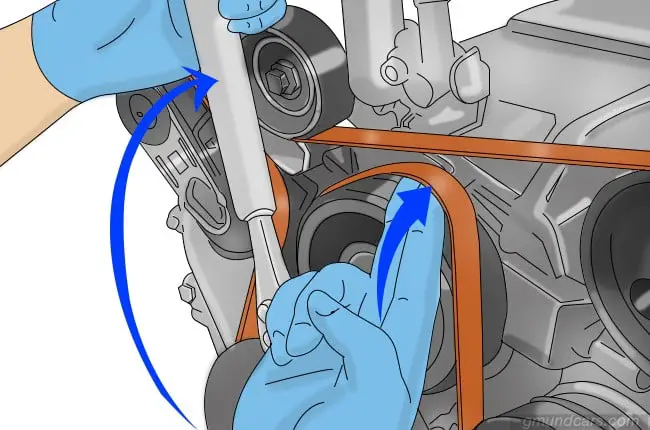
Step 4: Inspect the alignment of the grooves of the belt with the pulleys
When the installation stage is done, you can use a flashlight to check whether the belt location on the pulleys is aligned with the grooves of the belt. If no, adjust it. If yes, you complete the serpentine belt replacement successfully.
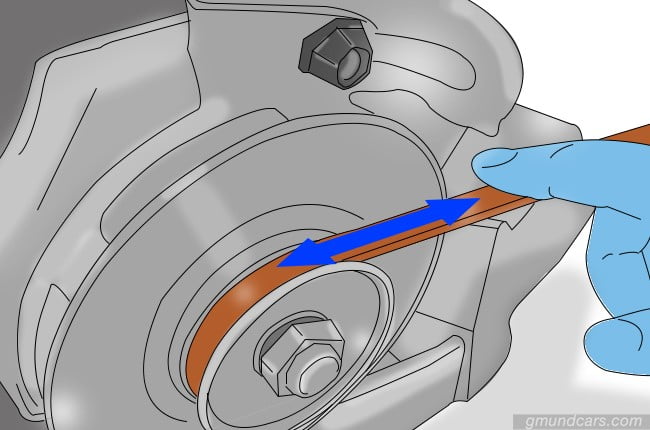
How much does it cost to replace a serpentine belt?
DIY
Replacing a serpentine belt is not rocket science. Anybody can do it. If you’re sure you know what you’re doing and you aren’t willing to part with much more cash than is necessary, then DIY is okay.
Changing the belt yourself saves you some money. You won’t have to pay for services, labor charges, or something like that. Get a new belt for around 25 to 75 dollars, and then you’re good.
If, in any case, it gets complex and you think you might need an extra hand, then call a friend. The entire fixing shouldn’t last for more than an hour (or two, at most), though your vehicle’s model matters too. While some vehicles’ frameworks allow belts to fit in easily, some don’t.
Go to the shop
Going to shop for belt replacement or inviting a pro is expensive. And trust me, it can always be avoided. No, I’m not saying it’s wrong to do so; I’m only suggesting you go for a cheaper, more cost-friendly alternative – DIY.
If you’re taking your vehicle to shop, you should be ready to shell out more cash. Besides the 25-75 dollars for the belt, you’d have to pay charges of around 75 to 120 dollars. And that’s about 100 to 195 dollars in total.
Now think about it.
Conclusion
A car without a drive belt is like a body without a spirit and as good as dead. No vehicle runs perfectly without something to transfer power to its engine parts and that’s why you need a serpentine belt. Whether it is A/C, power steering, car engine, and whatnot; none would work if the serpentine belt breaks or stops functioning completely. So you should look out for some of the signs mentioned above and replace your belt when necessary.